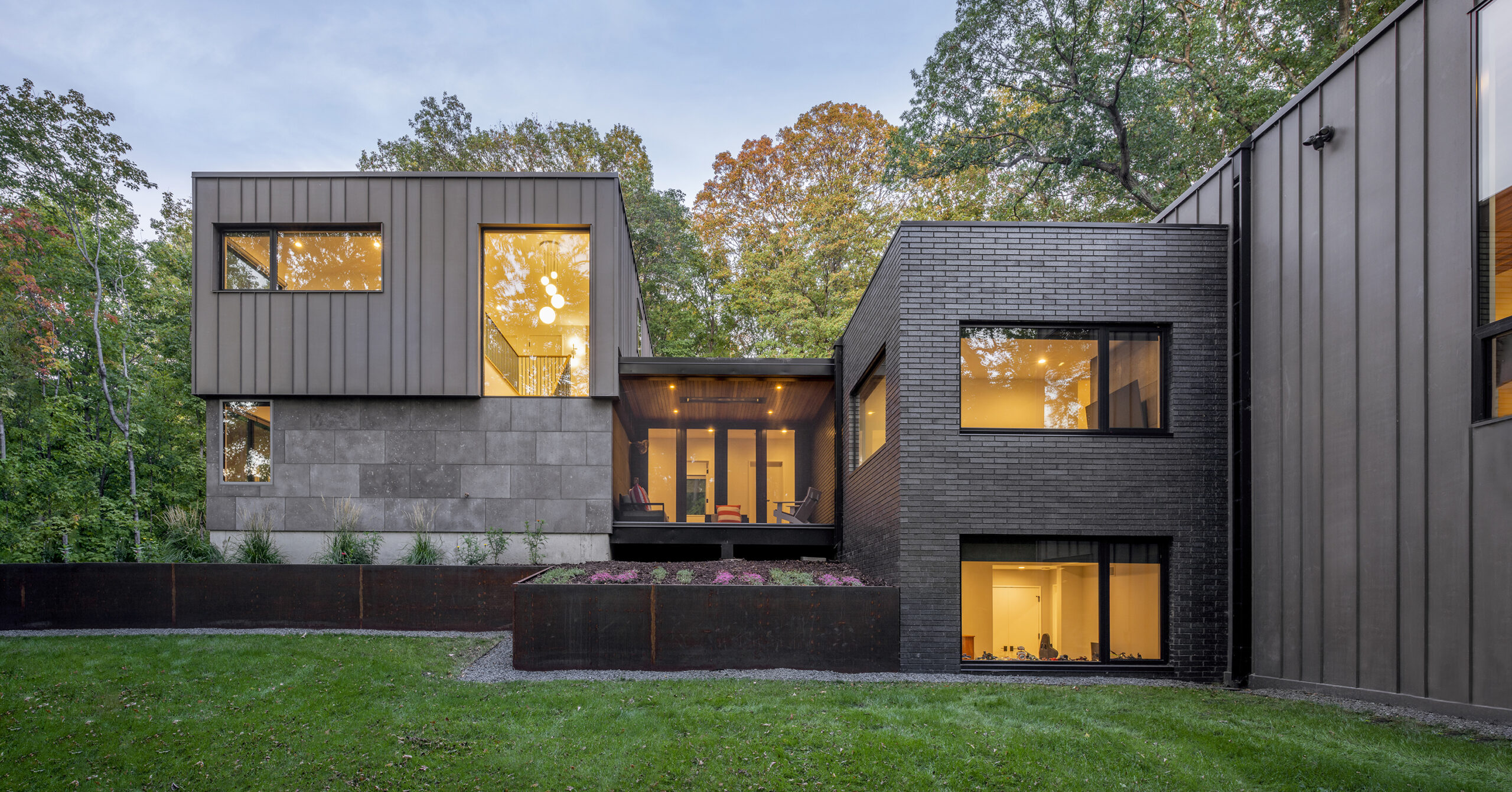Doors not only bridge the gap between spaces, but are also technical innovations and design statements in their own right. As crucial components of architecture, doors require careful consideration during the design and specification process.
From enhancing aesthetics to ensuring functionality and security, the selection of doors can significantly impact the overall success of a project. In turn, they reflect the character and personality of designers and clients alike.

Marvin Ultimate Multi-Slide door; image courtesy of Marvin.
Marvin, a manufacturer of custom windows and doors, is well attuned to the importance of doors in everyday life. George Marvin began the company over a hundred years ago in 1912 as a family-owned and operated cedar and lumber company. Their core mission has been to help people live better. With roots in Warroad, Minnesota, the company has products that are now used around the world, offering architects, builders, and homeowners a greater connection to their surroundings.
In this guide, we delve into the intricacies of specifying doors, from material selection and design considerations to technical requirements and sustainability concerns. Additionally, we spotlight Marvin and their commitment to craftsmanship, innovation, and quality. Whether you’re designing a residential masterpiece, a commercial complex, or a public institution, the guide aims to equip architects with the knowledge and resources needed to make informed decisions on the selection of high-quality doors.
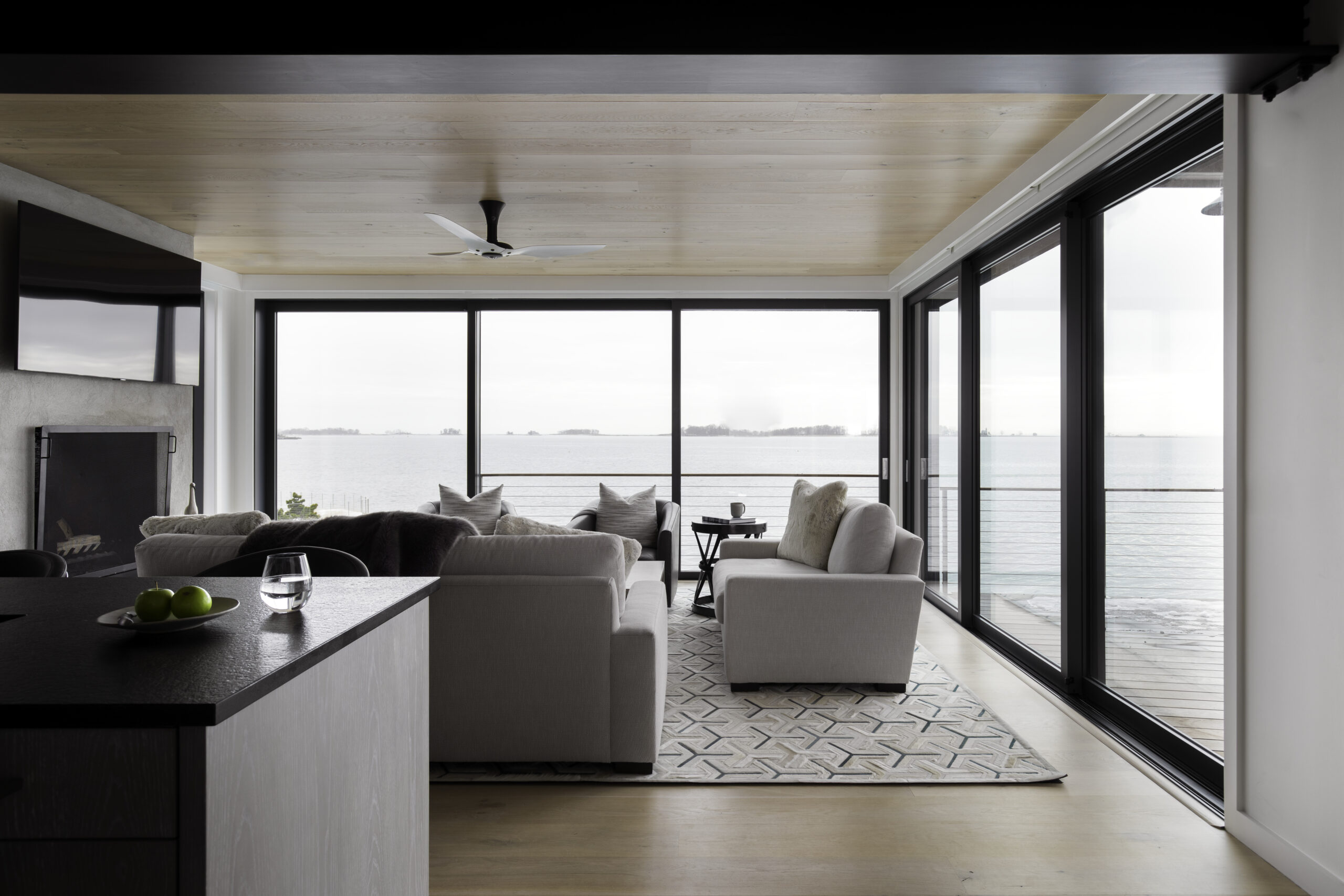
Marvin Modern Multi-Slide doors; image courtesy of Marvin.
Materials
Doors can be crafted using a wide range of materials. At Marvin, the chosen material and door style is typically inspired by how people want to live. Whether it’s a classic French patio door, a modern swinging door, or a large scenic door that blurs the boundaries between indoors and out, Marvin doors provide a vast range of custom sizes, configurations, and design options for residential, commercial and replacements, as well as remodel projects.
Generally speaking, solid wood, solid core and hollow core are some of the most common materials used for interior applications. Exterior doors are often made of wood, steel, aluminum or fiberglass-composite. Architects typically specify materials for the door and frame based on factors like durability, aesthetics, maintenance, and budget.

Marvin Elevate Sliding Patio door; image courtesy of Marvin.
Exterior Applications:
- Solid Wood: Common among exterior applications, solid wood doors offer great versatility and opportunities for customization. Natural-finish stock and custom wood doors come in oak, cherry, walnut, mahogany, maple, fir and pine. You’ll also find paint-grade doors in several softwood varieties, such as pine and western hemlock. Many wood doors are a sandwich of wood-veneer skins and an engineered-wood core, which helps minimize warping.
- Steel: Steel is the best option when security and durability are top concerns in your design. Steel doors are stronger than wood and fiberglass doors, and neither crack nor warp. All steel doors have an inner frame made of either wood or steel. The cavities within this frame are filled with high-density foam insulation.
- Aluminum: Aluminum doors come in a huge variety of styles and colors, with smooth or wood-grain finishes. Additionally, they have an enamel finish, which means that the door will not rust or require maintenance.
- Fiberglass-Composite: Tough and maintenance-free, fiberglass-composite doors are a smart choice for harsh or humid climates. They mimic the look of wood with wood-grain texturing and can be stained to match oak, cherry, walnut and a variety of other woods. Beneath their molded surface is a framework of wooden stiles and rails, including wood edges for the lockset. Voids in the framework are filled with polyurethane-foam insulation.

Ultimate Sliding door rendering showcasing the interior wood material; image courtesy of Marvin.
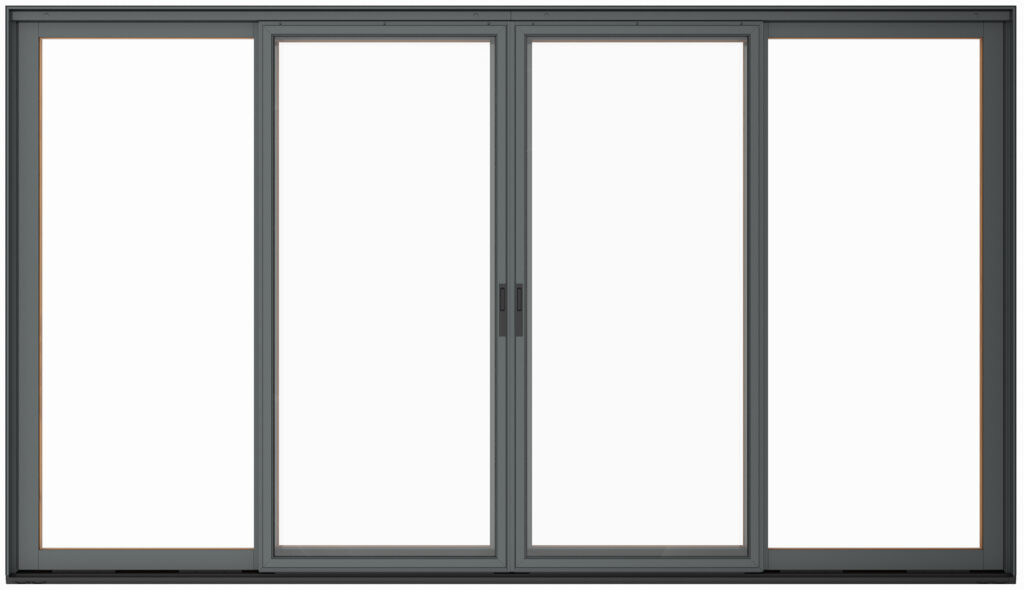
Ultimate Sliding door rendering showcasing the exterior aluminum material; image courtesy of Marvin.
Marvin exterior doors include those in the Ultimate product line, offering beautiful design, craftsman-quality construction, and the widest selection of shapes, styles, sizes, and options. In addition, doors within the Modern product line comprise an extruded aluminum interior and high-density fiberglass exterior and meet the exacting principles of modern design. The Essential collection use a fiberglass interior and exterior, while doors in the Elevate collection combine a wood interior with a fiberglass exterior and streamlined finishes and options to choose from. This flexibility and range of offerings enables the manufacturer to meet evolving consumer demands.
Interior Applications:
- Solid Wood: Solid wood doors are extremely sturdy and weather very well. While it is often the most expensive option, many buyers consider solid wood to be of good value due to its long-lasting composition. Solid wood interior doors also offer great insulation and act as a natural sound barrier.
- Solid Core: Solid-core doors are made from plywood or molded composite exterior, with a filled-wood-fiber interior. Solid-core doors generally look and feel similar to that of a solid wood door, maintaining the same aesthetic quality while offering good insulation and sound barrier between rooms. However, they are more likely to expand and contract with rising heat and moisture levels, which may present an issue depending on where your project is located.
- Hollow Core: Generally the least expensive option, hollow core doors are constructed from a wooden frame, plywood or hardwood surface and filled with rigid cardboard to maintain their shape. They are not as durable or fire-resistant as the solid doors. Not surprisingly, the acoustic performance is also weaker. A benefit of hollow core doors is that they do not warp with humidity.
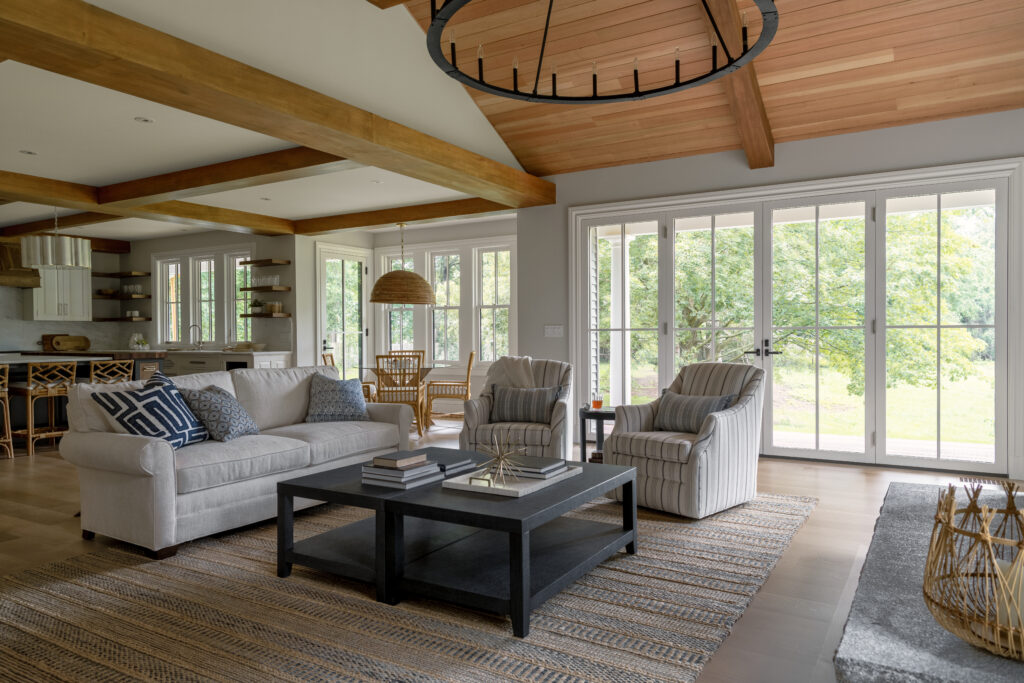
Marvin Ultimate Narrow Profile Swinging doors; image courtesy of Marvin.
Door Types
There are many different types of doors, which should be chosen based on material preference, operating type and safety considerations. Marvin offers nine key door types:
Sliding Doors: Sliding doors have one or more panels opening on either a sliding track or hanging rollers. They are space saving and help open up a room. The different styles of sliding doors include multi-slide doors, French doors, barn doors, pocket doors, lift-and-slide doors, and patio doors (sometimes called a sliding glass door). Marvin’s recently launched Ultimate Sliding door breaks new ground in this category, featuring aluminum-clad doors with a streamlined design that matches the aesthetics of swinging doors.

The new Ultimate Sliding door (horizontal cross-section shown here in an OXXO configuration) breaks new ground for aluminum clad-wood products by featuring a streamlined design with no visible vinyl on the interior and exterior when closed, symmetry and alignment of the meeting stiles, and a lack of interior glazing beads, jamb liners or profiled interior stops to eliminate shadow lines.
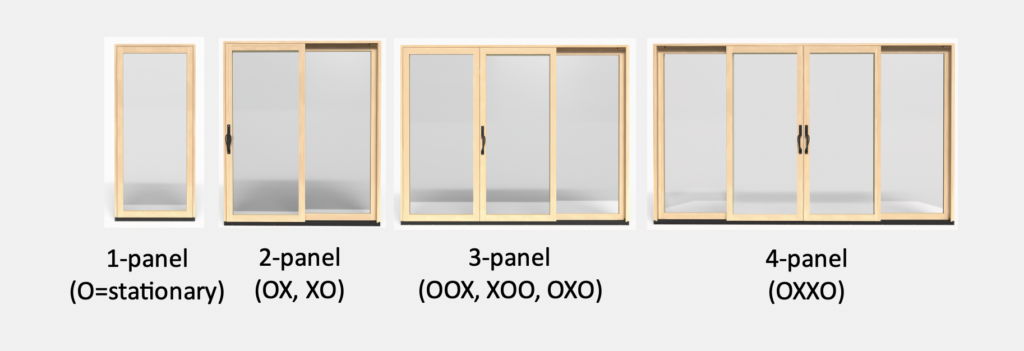
Marvin Ultimate Sliding door system is available in up to four panels and offers seven standard configuration options.
Multi-slide Doors: Multi-slide door types have more than one moving panel that either stack or conceal in a wall pocket when opened. They serve to add broad views and openings. Multi-slide doors are sliding doors with more than one moving panel aligned in a row. When open, the panels either stack side-by-side near the edge of the frame or disappear into a wall pocket. Thanks to their many panels, multi-slide doors present huge openings, some reaching heights up to 12 feet tall and widths over 50 feet.
Bi-fold Doors: Also known as folding or accordion doors, have two or more folding hinged panels. They are a popular style for patio doors. They consist of multiple panels hinged to each other that fold open and close like an accordion. Interior bi-fold doors are often used for closets or pantries and usually have two panels. Exterior bi-fold doors can feature many floor-to-ceiling glass panels and open to present an entry and exit space up to 55 feet long.
Commercial Doors: These Marvin doors combine sophisticated design with the rugged durability to stand up to years of commercial use. They are available in a wide variety of design and customization options.
Entry Doors: For this door type, they usually provide passage between a house and an outdoor space or garage. These doors feature one or more panels that swing open and closed on hinges. Entry doors are made with a more durable construction. Common panel materials include aluminum, composite, fiberglass, steel, or wood. Unlike interior swinging doors, entry doors have weatherstripping and a threshold to provide protection from harsh weather conditions. Many also have glass panels or transom and sidelight windows to allow for natural light and improved sightlines.
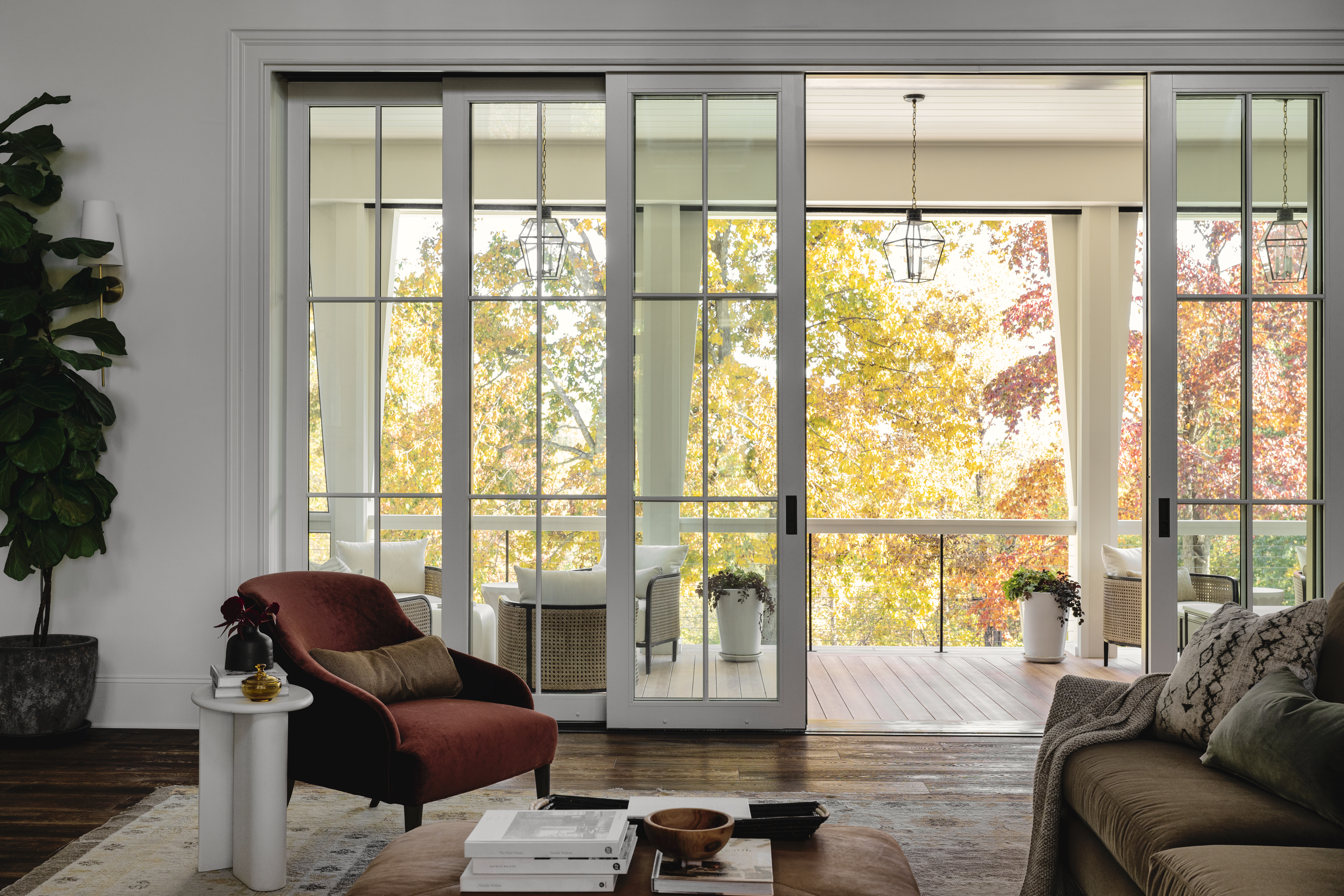
Marvin Ultimate Multi-Slide door; image courtesy of Marvin.
Interior Doors: As a Marvin brand, TruStile offers a variety of interior and entry doors all made-to-order. In 1995 TruStile set out to create the best interior doors in the industry by using only the highest quality materials and providing the most flexible design opportunities. In 2015 TruStile was acquired by Marvin. They now offer a range of styles from panel and modern doors to glass and speciality doors.
Lift and Slide: The Marvin Ultimate Lift and Slide door pairs well with large door panels with effortless, fingertip operation thanks to a carefully-engineered carriage system that lifts panels off their track for weightless operation. They include versions as wood interior, wood or aluminum-clad exterior, with openings up to 47’ wide by 12’ high. You can choose from 22 operating configurations.
Swinging Doors: The most common style of door, swinging doors feature one or multiple-hinged panels that swing open and closed. Swinging doors are available in single or multiple panel designs. The direction a door swings, either to the right or left, is known as its “handing.” Exterior swinging doors are also differentiated by whether they open into the building or out of it, termed “inswing” or “outswing.”
Garage Doors: The Coastline Garage door is a complement to any contemporary style. You can design a showcase piece with clear glass or obscure the view while preserving the natural light with tinting or a decorative glass coating. Made with durable and low-maintenance extruded aluminum and impact-resistant glass. It is available in widths over 18′ and heights over 14′ with a max area of 229 square feet.

Marvin Ultimate Bi-Fold door; image courtesy of Marvin.
Aesthetics
Considering aesthetics when specifying doors is crucial because doors play a significant role in shaping the visual identity and overall ambiance of a space. As one of the most visible architectural elements, doors contribute to the design narrative and set the tone for the entire building. Moreover, doors serve as focal points that draw attention and add character to interior and exterior spaces.
Dimensions: Always specify the height, width and desired thickness of your door. It is also important to note that by ADA standards, doors must have a width-clearance of at least 32-inches.
Paint: Some door products come with a layer of primer already on, making them a perfect canvas for a paint job. Ask your manufacturer what type of paint they recommend, based on the door you have selected, or choose an interior finish where the manufacturer paints/finishes the door — Marvin offers white, black or clear-coat options.
Hardware: Door hardware parts, including door knobs, deadbolts, hinges and knockers, are offered in many finishes such as brass, bronze, pewter, chrome, nickel and black. For added depth, you can also consider one with a distressed, oil-rubbed, matte, satin, aged or antique finish.
Door Frames: A sometimes overlooked component is the door frame, which is a crucial factor for both safety measures and thermal performance. Common materials include vinyl, wood, fiberglass, metal and composite frames.
Design Details
Square Sticking: Square sticking creates a clean, squared-off transition on the interior edge of a window or door where glass meets the frame — ideal for a sleek contemporary look.
Authentic or Simulated Divided Lites (ADL / SDL): In windows and doors, an authentic divided lite (ADL) entails separate pieces of glass glazed between muntin bars, while simulated divided lite (SDL) bars are permanently adhered to both sides of a single piece of glass for a more energy-efficient option.
Mulling: Large window walls that open spaces to the outdoors create the opportunity for impressive views. Marvin has extensive mulling capabilities to allow for larger certified assemblies with greater expanses of glass.
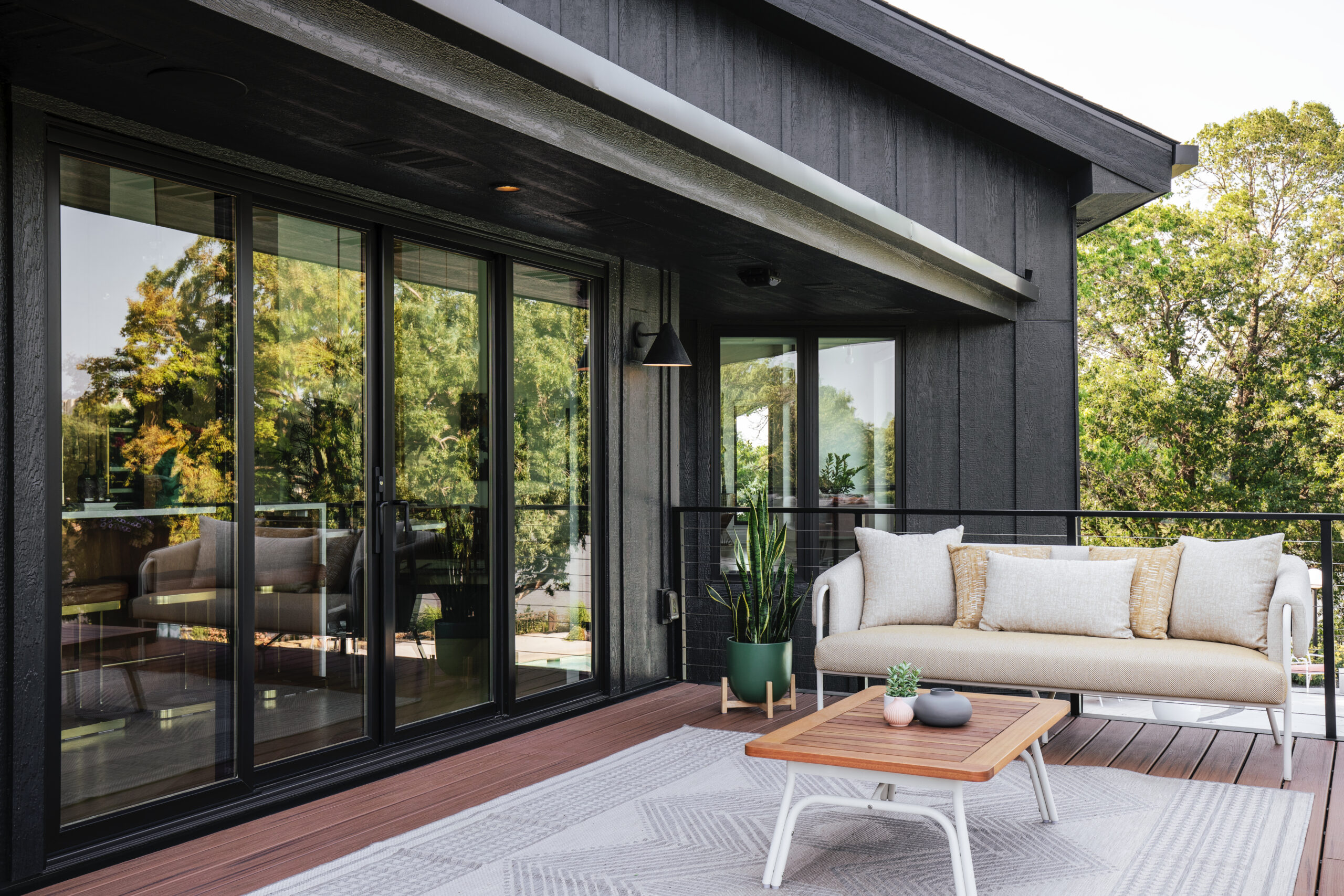
Marvin Elevate Sliding Patio door; image courtesy of Marvin.
Performance
Ensure that doors meet fire rating requirements if applicable, and specify safety features such as panic hardware and signage for emergency exits. Consider the need for soundproofing and thermal insulation, especially for doors in sensitive areas or energy-efficient buildings. In addition to the following considerations, always check the technical specifications of manufacturers to ensure proper performance.
Security and Privacy: If security is a concern, consult with your manufacturer as there may be systems available to increase the door’s performance using alarms, lights and high performance locks.
Fire Resistance: Fire resistant doors typically receive 90, 60, 45 or 20-minute ratings. Fire resistant door materials may vary from steel to MDF, and can be customized to fit the desired aesthetics of your projects.
Energy Efficiency: A door typically has less glass and a higher glass-to-frame ratio than windows, so it inherently carries more insulation properties than windows. For exterior doors, such as patio doors and other sliding varieties, always check the insulation level of the glazing with the manufacturer. Marvin has put together an extensive guide to energy efficiency as a resource for designers.
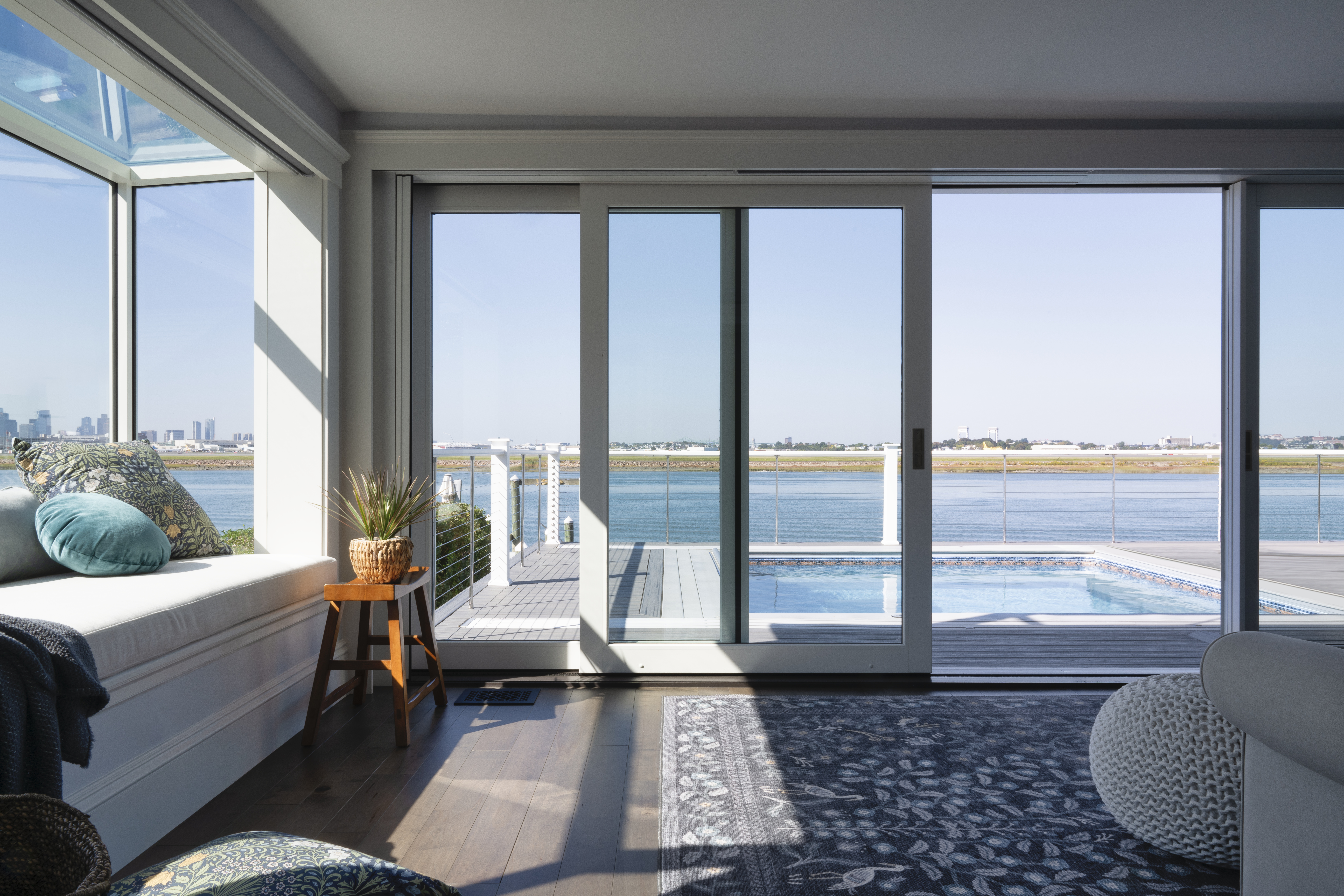
Marvin Skycove and Ultimate Multi-Slide door; image courtesy of Marvin.
Coastal Ratings: Homes on the coast or in hurricane impact zones demand stronger protection against the elements, so it’s important to understand impact-resistance, impact ratings and other measures for creating a shield against extreme conditions. Marvin offers IZ3 and IZ4 rated products for coastal properties that need to meet zoning requirements.
Accessibility: Ensure that doors comply with accessibility standards, including width, clearance, operability, and hardware height.
Case Studies
Green Mountain Views by Wadsworth Design Build
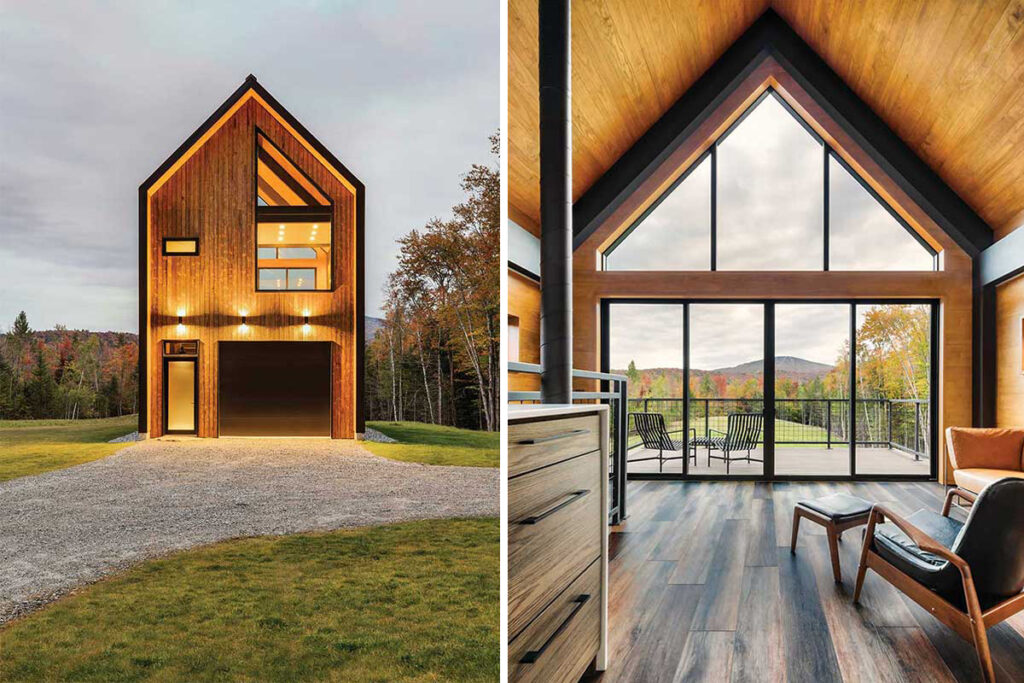
Images courtesy of Marvin.
The clients for an intriguing barn-like retreat near Stratton Mountain in Vermont were initially looking to build a garage to store mountain bikes and gym equipment, with two doors to drive a snowmobile in one side and out the other without having to back it up. After consulting with Wadsworth Design Build, the project expanded into a guest house with sleek living quarters above the multi-use garage space below. This project features three Marvin product lines: windows from both Marvin Modern and Marvin Essential and a Marvin Elevate sliding patio door.
Hadley House by SeaGlass Architects
Originally built in the mid-19th century, Hadley House was in need of a transformative restoration. Novack Properties, SeaGlass Architects, and Jackson’s General Carpentry set out to reimagine the home for the 21st century. After consulting historical documents and photos, the property was meticulously redesigned to capture its historic personality outside but with interior spaces suited to today’s lifestyle. Marvin custom created 7-foot-tall double-hung windows for the house from their Ultimate line, while TruStile interior doors were used in the dining room, sitting room, and the hallway’s two vestibules.
A Glass House on the Water by Charlie & Co. Design

Image courtesy of Marvin.
The brief for this stunning contemporary home on the banks of Minnesota’s Lake Minnetonka called for a design that maximized light and forged an intimate relationship with the external world. Thanks to magnificent expanses of glass, the residence is a conduit for the surrounding landscape — an elegant, architectural “picture frame”. The team turned to Marvin to help them deliver the seamless, streamlined esthetic their client wanted. The Marvin Modern product line, comprising a modular series of durable, fiberglass products with narrow sightlines, was the ideal fit for the ambitious design.
To explore more case studies and learn how to harness windows and doors like these for your next project, click here.
